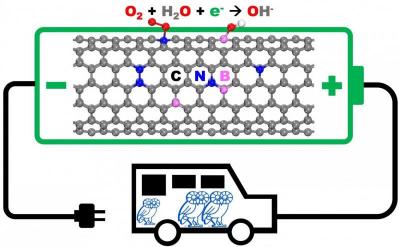Researchers from Rice University have discovered that nitrogen-doped carbon nanotubes or modified graphene nanoribbons could potentially replace platinum, one of the most expensive facets in fuel cells, for performing fast oxygen reductionâa crucial reaction that transforms chemical energy into electricity.

The researchers used computer simulations to see how carbon nanomaterials can be improved for fuel-cell cathodes and discovered the atom-level mechanisms by which doped nanomaterials catalyze oxygen reduction reactions. The simulations also revealed why graphene nanoribbons and carbon nanotubes modified with nitrogen and/or boron are so sluggish and how they can be improved.
In a simple fuel cell, anodes draw in hydrogen fuel and separate it into protons and electrons. While the negative electrons flow out as usable current, the positive protons are drawn to the cathode, where they recombine with returning electrons and oxygen to produce water. The researchers found that thinner carbon nanotubes with a relatively high concentration of nitrogen perform best because the oxygen atoms readily bond to the carbon atom nearest the nitrogen.
The team found that using nanotubes is more advantageous than using nanoribbons because of their curvature, which distorts chemical bonds around their circumference and leads to easier binding. However, it is difficult to make a catalyst that is neither too strong nor too weak as it bonds with oxygen. The curve of the nanotube provides an avenue to tune the nanotubes’ binding energy. The researchers determined that nanotubes with a radius between seven and 10 angstroms is ideal.
They also found that co-doping graphene nanoribbons with nitrogen and boron enhances the oxygen-absorbing abilities of ribbons with zigzag edges, where oxygen finds a double-bonding opportunity. They first attach directly to positively charged boron-doped sites and then are drawn by carbon atoms with high spin charge, which interacts with the oxygen atoms’ spin-polarized electron orbitals. The same principles held true, but to a lesser extent, for nanoribbons with armchair edges.
While doped nanotubes show good promise, the best performance can probably be achieved at the nanoribbon zigzag edges where nitrogen substitution can expose the so-called pyridinic nitrogen, which has known catalytic activity, Rice theoretical physicist said.
While the spin effect enhances adsorption, the binding energy remains weak, also achieving a balance that allows for good catalytic performance.



